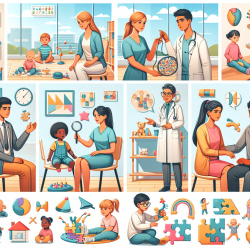Introduction
In the ever-evolving field of speech-language pathology, practitioners are continually seeking evidence-based strategies to enhance their therapeutic interventions. A recent study titled Coordinated social communication in toddlers with and without autism spectrum disorder during a home observation provides valuable insights into the development of coordinated social communication in young children. This blog aims to translate these findings into actionable steps for practitioners working with children with autism spectrum disorder (ASD) and developmental delays (DD).
Key Findings from the Study
The study, conducted by Delehanty and Wetherby, utilized a prospective, longitudinal design to observe toddlers during naturalistic home settings. The research focused on the coordination of gestures, sounds, and words among toddlers with ASD, DD, and typical development (TD). The findings highlighted several critical points:
- Children with ASD used sounds and gesture-sound combinations at significantly lower rates than their DD and TD counterparts.
- Both ASD and DD groups coordinated gestures with single words and phrases less frequently than the TD group.
- The rate of single words and gesture-word combinations was significantly correlated with measures of social communication, language skills, and autism symptoms.
Implications for Practitioners
The results of this study underscore the importance of incorporating coordinated social communication into early intervention strategies. Here are some practical applications for practitioners:
- Observation and Encouragement: Practitioners should observe and encourage the use of coordinated gestures and speech during home visits. This can be integrated into routine screenings and assessments for ASD and DD.
- Intervention Targets: Focus on intervention targets that promote the use of gesture-speech combinations. This could include modeling and encouraging the use of gestures alongside verbal communication.
- Parental Involvement: Educate parents on the importance of responding to their child’s coordinated communicative acts. Parental responses can provide the child with the language input needed to support learning.
Encouraging Further Research
While this study provides significant insights, it also highlights areas for further research. Practitioners are encouraged to explore the following:
- Investigate the impact of coordinated social communication interventions on long-term language outcomes in children with ASD and DD.
- Examine the role of caregiver responses in enhancing coordinated communication skills.
- Explore the integration of technology, such as online therapy platforms, in delivering coordinated communication interventions.
Conclusion
The study by Delehanty and Wetherby offers valuable data-driven insights into the development of coordinated social communication in toddlers. By implementing the findings into practice, speech-language pathologists can enhance their interventions, ultimately improving outcomes for children with ASD and DD. For practitioners interested in delving deeper into the research, the original study is accessible here.










